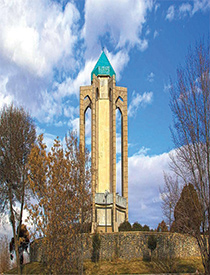Baba Taher Oryan Mausoleum
Baba Taher is a noted poet who lived in the 11th century in Hamadan, though his exact dates of birth and death are unknown. Baba Taher Oryan Mausoleum in Hamadan was built from 1967-70 by the National Monuments Association of Iran. The interior of the eight-pillared tomb features 24 pieces of marble inscribed with verses from the poems of Baba Taher. This tomb is one of the interesting places that should not be missed by avid tourists.

Description
Baba Taher Hamedani is a poet of the fourth century and the fifth century AH. He lived in the Seljuq period. “Baba” (Father) as a sobriquet given to devoted disciples, and he was called “Oryan” (Naked) because he had dismissed worldly concerns. In Lorstan, “Baba” is used for spiritual guides of Ahl-e Haqq (People of Truth). There is not enough information about Baba Tahir’s family and life. According to Najmoddin Rawandi in Rahat al-sodur, Baba Tahir visited Seljuk Toghrul in 447 AH and was respected by him.
His tomb located on a hill in the northwest of Hamedan. Baba Taher Oryan Mausoleum is based on an octagon form. Eight pillars of the tower, stone slabs of the tomb and its base, together with the steps and the surrounding paved area, are all of the sculptured granite. The main structure mausoleum is the dimensions of 10m. x10 m. and has entrances along with light sutures. The facade and flooring of the structure are of Granite stone, and inscriptions are worked with tiles. The Mausoleum had been registered as one of Iranian National Monuments in May 11, 1997.
Baba Taher's Poems
During his lifetime, great changes were occurring in the development of literature and art in Persia. Baba Taher is best known because of his do-baytis. Do-bayti is a quatrain composed in a simpler meter in comparison to the standard rubai. Iranians recite Baba Taher’s poems, accompanied by a traditional musical instrument, setar. This very ancient style of poetry is known as Pahlaviat. Baba Taher’s do-baytis consist of the local dialect of that period. It is close to the dialect spoken at present by the Jews of Hamedan. In his poems, Baba Taher talks about love and mysticism rather than philosophical themes.
Architecture of the mausoleum
The tomb was constructed for the first time during the Seljuk era, But it underwent many reconstructions after that. During these reconstructions, archeologists found a tile tablet from the 7th century AH. There are verses of the Quran written in Kufic script on this turquoise tile. It is now held in the National Museum of Iran. The original octagonal structure dates back to the 12th century. In Reza Shah’s period, another brick structure was constructed over his grave. Finally, in 1970, the famous Iranian architect, Mohsen Foroughi, designed the current structure.